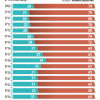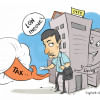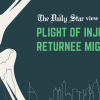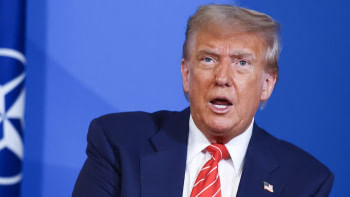Social Safety Net Spending: Big slice goes to non-poor

In circuses, whenever artists perform the tightrope walking stunt, underneath them are wide nets to prevent them from falling to the ground and avoiding potentially life-threatening injuries -- lest they lose their balance on the thin rope and falls over.
In the same manner, the social safety nets are meant to stop people from hitting rock-bottom.
But if one looks at Bangladesh's social safety net programme, a large chunk of it is not designed for that end and is actually meant for the non-poor.
For instance, 29.5 percent of the Tk 107,614 crore-social safety net budget for fiscal 2021-22 is for providing pensions for the 7.5 lakh government employees and honorarium for freedom fighters' families -- people who are not facing destitution.
Then comes the allocation for the money kept for interest payment on national savings certificates and interest subsidy for loans to small and medium enterprises (including cottage industries), which took up another 9 percent of the social safety net budget.
If the educational stipends and the agriculture subsidy are taken out, the pot becomes even smaller.
On paper, social safety net spending accounts for 3.1 percent of the GDP.
However, if the fat is trimmed, what actually goes to the truly poor account for 0.97 percent of the GDP.
It was 0.73 percent of GDP, according to a 2018 study of the World Bank titled 'The State of Social Safety Nets'.
The spending had reduced the number of people living in extreme poverty (less than $1.90 a day) by 36 percent on average in the countries examined by the WB.
Bangladesh's spending was higher than the amount spent by Sri Lanka, Pakistan and Bhutan but lower than the South Asian mean of 0.9 percent of GDP. It was also lower than the average of 1.5 percent of GDP by the developing countries, the study found.
In short, even though the proposed social safety net budget for the incoming fiscal year is an increase of 12.5 percent from this year's, Bangladesh's poor -- and also the new poor from the pandemic -- would not be proportionately benefitted.
Although the government has increased the allocation for social protection, it is still insignificant and inadequate, said Selim Raihan, executive director of South Asian Network on Economic Modelling (SANEM), a think-tank.
In fact, the allocation for social protection was low even before the pandemic.
"We cannot include pension and interest on savings certificate under the social safety net programmes as those are not counted internationally. Even when the WB and the Asian Development Bank do the analysis, they also exclude these from the safety net schemes," he added.
Given the devastation of the pandemic, the government proposed to expand the safety net coverage by bringing around 14 lakh new people under social protection.
However, the allocation per beneficiary would not go up in terms of amount.
The old-age allowance is the case in point.
Though the beneficiaries will increase to more than 57 lakh, they will get only Tk 500 every month. The expenditure in Bangladesh's old-age allowance scheme, introduced in fiscal 1997-98, is one of the lowest in the world.
So is the case of the allowance for widows and deserted women.
They will get a monthly cash allowance of Tk 500, although the government proposed bringing more than 4.75 lakh more beneficiaries in fiscal 2021-22.
Launched in fiscal 1998-99, the monthly allowance under the scheme was initially Tk 100 and raised to Tk 500 three years ago.
In India, the elderly allowance (aged 60-79) is Tk 720 (Rs 600) and those aged over 80 get Tk 1,200 a month. In Delhi, the allowance for a widow is Tk 1,000 per month.
On average, a person needed Tk 1,862 every month to maintain a minimum standard of living in 2016, according to a survey of the Bangladesh Bureau of Statistics.
The economists said the amount of both the schemes is insignificant considering inflation and the price hike of essentials.
"Although the prime minister increased the amount, it is still very insignificant given the inflation. For years, it has not been revised," said Raihan, who teaches economics at Dhaka University.
CHALLENGES THERE TOO
Economists maintained that delivering the support to intended beneficiaries is the main challenge as there were previous examples of irregularities like the inclusion of ineligible beneficiaries with political connections, leaving many genuine ones out.
In September last year, a Centre for Policy Dialogue (CPD) study found that 65 percent of the fund from the government's social safety net programmes went to the non-poor owing to nepotism, corruption and political consideration in selecting beneficiaries.
Titled "Efficiency of Delivering Social Protection Programmes in the North-West Region", the study conducted by the CPD said the safety net programmes can only cover a fraction of the total poor population as just 32.5 percent of poor households received some form of assistance.
Raihan suggested that the government should prepare the database of the beneficiaries in a transparent manner with the involvement of the local administration, local public representatives and non-governmental organisations.
"There were allegations against some elected representatives that they incorporated names of people of their choice. So, we must have a cross-checking system in place so that people in need get the benefits," he added.
Another aspect of the proposed allocation for the social safety net is that it did not have anything about the "new poor" who have lost their jobs during the pandemic.
The economic shock induced by the pandemic has pushed 2.45 crore people, 14.75 percent of the country's population, into poverty in one year, according to a survey of the Power and Participation Research Centre and the Brac Institute of Governance and Development.
This would imply that beyond the 20.5 percent of the population officially recognised as poor, there is a group of "new poor" representing an additional 22.9 percent of the population that needed to be brought within the discussion on poverty.
But the government has been denying that there is any new poor in the country.
"Since the government keeps denying having new poor, they would not feel the urge to increase the coverage. That's what has reflected in the budget," Raihan said.
Speaking to this newspaper earlier this week, Finance Minister AHM Mustafa Kamal said: "We don't know new or old poor. The government will provide assistance to whoever is poor."
About the listing of beneficiaries, he said a team led by the deputy commissioner and comprised of UNO and local representatives are preparing the list of real beneficiaries.


 For all latest news, follow The Daily Star's Google News channel.
For all latest news, follow The Daily Star's Google News channel. 








Comments